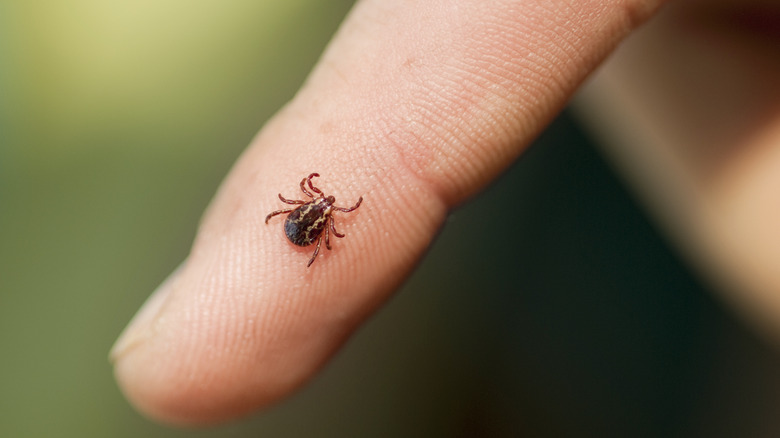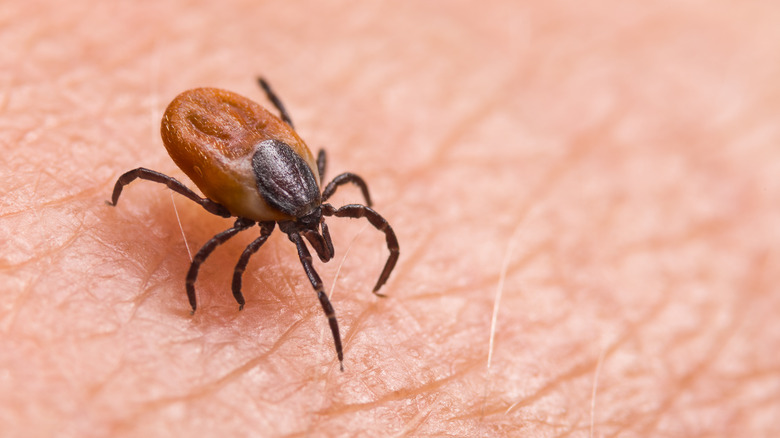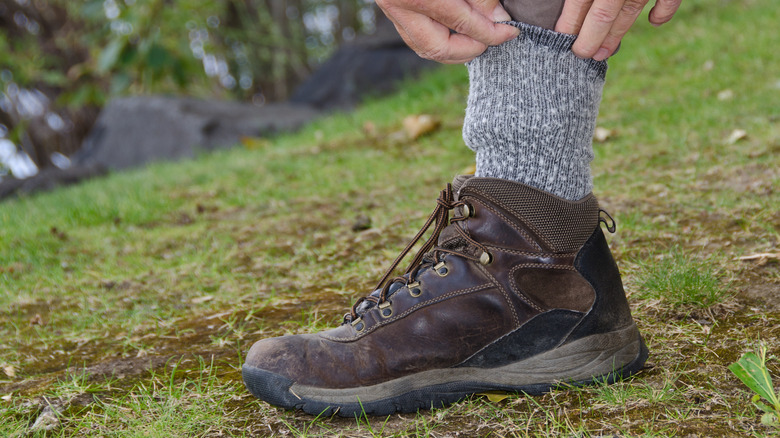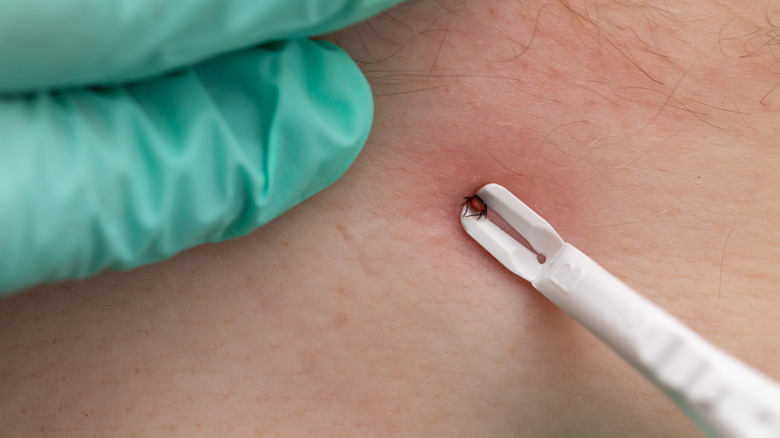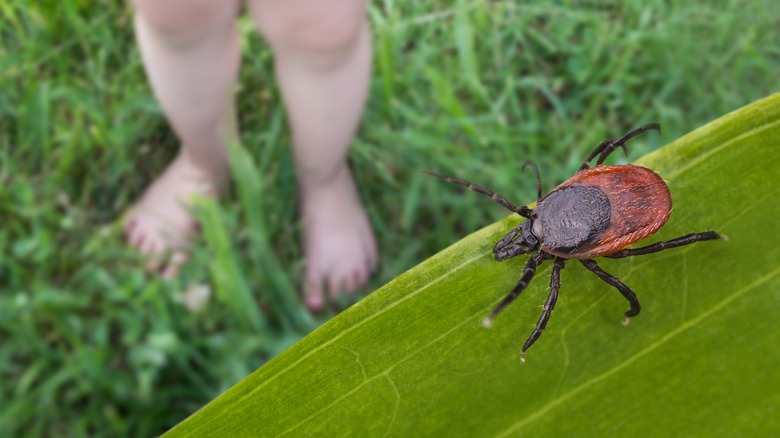Tick Safety 101: 12 Tips To Avoid Bites On Your Next Trip
There are a wide variety of beneficial insects in this world. Some are helpers in the garden, while others, like spiders, are best viewed at a distance. However, if there are any bugs you don't want crawling around in your tent and attaching themselves to you, it's ticks. Perhaps more reviled than the mosquito, ticks are notorious harbingers of a number of different diseases, the most famous of which is Lyme Disease. Though despised the world over, they are, unfortunately, extremely common.
Remember the times you went hiking and strayed through the tall grass? How many times was there a tick attached to your body? These bloodsuckers are indiscriminate when it comes to who or what they cling to. And the longer they are attached, the higher the likelihood of some sort of disease being passed onto their victim.
Though we cannot eliminate the fact that ticks exist, there is plenty we can do to ensure that we are not at their mercy when exploring the great outdoors. Here are 12 tips to follow to avoid bites on your next trip.
Know where the ticks are
The best way to avoid being bitten by ticks is to know exactly where they like to live. Ticks are among the most common insects found across the United States. Much of what happens after you're bitten depends on what kind of tick is sucking your blood, but we'll get to that later. If there is a commonality between ticks, it is that they all prefer the same kinds of environments. These are areas you should be wary of when you're out hiking and avoid whenever possible.
Ticks prefer to live where there is plenty of brush and tree cover, and in plains of tall grass. These areas provide them with plenty of cover, which means that they are going to see you long before you see them. One could easily attach itself to you if you walk through tall blades of grass or pass under low-hanging tree branches.
Ticks also like to live in the leaf piles, soil, and grass of a backyard. In fact, according to the CDC, a majority of bites happen within one's own neighborhood. Though primarily active in the summertime, ticks will live through colder weather. So, if you fancy a jump in the leaf pile with your kids or a roll down your hill, make sure you do a decent examination for ticks when you emerge. They won't just vanish because it's cold outside.
Wear repellent clothing
It doesn't take much to build up a sweat when you're out hiking. Therefore, you may think that it would be better to wear shorts and sandals for your hike. This, however, would be a classic hiking mistake. Wearing shorts for your walk in the woods is definitely going to leave you at more risk of tick bites than if you were wearing longer pants. In general, there are some clothing rules you need to follow when hiking as a way of avoiding ticks.
Stick to long pants, tucked-in shirts, and long socks. The latter are particularly helpful because they can ward off ticks in a number of different ways. Firstly, they protect your legs. So, if you're one of those people who absolutely has to wear shorts for a hike, opt for some longer socks for added protection. Second, if the socks are brightly colored, you will be able to see ticks a lot easier and remove them before they become an issue.
According to the Dutchess County Department of Behavioral and Community Health, ticks are less attracted to lighter colors than to darker ones. If you don't have longer socks, gaiters that attach to your boots and cover your ankles and calves are another option. Bright-colored hats are also good in case you brush through some lower branches.
Treat your gear
Another way to make your clothes the first line of defense against ticks is to treat them with a chemical solution. The most popular tick repellent is permethrin, a chemical insecticide derived from chrysanthemum flowers. According to the CDC, a minimum solution of 0.5% permethrin is required in order to properly repel ticks. Spray this on your clothing, boots, and socks, and allow it to dry completely before wearing.
Don't limit yourself to just treating your clothing. If you're going camping or are planning an extended, multi-day hike, you can treat all of your gear that has a porous surface, like your backpack and tent. Since ticks are attracted primarily towards body heat, there is no point in spraying anything you're going to be sleeping in, like your sleeping bag. A good spray on your tent will be enough to repel them from your sleeping area, and treating your backpack will also help keep them away from your body.
You could also purchase pre-treated clothing. This is a popular option because it removes the time required to treat your own clothing. Virtually all major outdoor retailers will sell tick-repellent clothing. Hunting stores will also sell camouflage tick repellent suits that provide enough protection to keep the ticks away while not giving off too much scent to ward off other animals.
Use good bug repellents
One reason you want permethrin to dry and cure into your clothing is that it cannot be applied wet to your skin. Permethrin is one of the more powerful chemical insecticides, and it can cause skin irritation, burning, and itching. Therefore, when it comes to using bug spray, stick with the more traditional sprays, chemical or otherwise.
If you've got no problems using traditional, store-bought bug sprays, then any brand that uses one of the five ingredients the CDC has deemed safe to spray will work. These include DEET, picaridin, oil of lemon eucalyptus, IR3535, and 2-undecanone. You can find these ingredients listed on the spray bottle itself.
If you are chemically averse, there is a case to be made for the use of essential oils as a means of repelling ticks. Pure oil of lemon eucalyptus can be used to ward off ticks. However, the CDC advises against using it on young children as it could cause irritating skin reactions. The oil in its pure form is also less effective than the proper insecticide. However, as Healthline notes, other essential oils like oregano, thyme, citronella, clove bud, neem seed, and peppermint work against ticks. So, regardless of where you stand, you have options.
Check for ticks
A good rule to follow when returning from a hike or even just being outside in your yard is to do a tick check. This means doing a thorough search for the little blighters, anywhere they might be. Now, there are two levels for tick checks: the public kind and the private kind. The public tick check is very straightforward. Check your clothes, gear, and any exposed skin for signs of a tick. One could be scuttling across your hat or crawling up your sock. It's easy to remove them at this stage. The private tick check is much more intimate.
The only way to make sure that you are 100% tick-free is to strip naked and check every crevice of your body. Ticks like to hide in places where they are not easily seen. This includes belly buttons, behind ears, in your hair, and, yes, your privates. If you have access to a handheld or full-body mirror, this check can be done solo. If you have a trusted partner, such as a spouse, you can do mutual checks. Parents must be in charge of checking their children.
Make tick checks a habit whenever you return from a hike. The faster you're able to locate ticks, the easier it will be for you to remove them. And the faster you remove ticks, the less likely you are to contract any type of tick-borne disease.
Shower
If the tick check doesn't leave you feeling satisfied as to whether or not these scurvy curs have evacuated from the surface of your body, the best thing to do is to hop in the shower. Whether you're just hosing off at the campground or taking a long soak in the comfort of your own bathroom, a good shower is incredibly effective at removing unattached ticks.
Showering is especially good at washing away those ticks that may be crawling around in your hair. Regardless of your hair color, ticks can be very difficult to spot when you're checking your scalp. The hot water of a shower will very easily wash away any ticks that have yet to latch to your head.
There are many who believe, too, that the hot shower water will kill the ticks. While it is true that hot water will kill ticks, it will only do so if the temperature reaches upwards of 130 degrees Fahrenheit. As the average shower doesn't typically exceed more than 105 degrees, your hose won't be killing those ticks you wash off of your body.
Check your pets
Our pets are perhaps the most notorious tick magnets. Anyone who has a dog or an outdoor cat knows that they are highly likely to come in laden with ticks after roaming around in the backyard. If you hike with your pet, you need to be especially careful. While cats kept in backpacks likely won't be an issue, dogs are particularly vulnerable. If you're not checking your animals for ticks after being outside, you're putting yourself and your pet at risk.
The American Kennel Club lists seven main areas to look for ticks on a dog. Check their head and ears, between their toes, around their tail, the groin, on or under the eyelids, under the collar, and under their arms. Use a fine-toothed comb to go over every inch of these areas. If unattached, the ticks will get caught in the bristles, and be easily removed. If attached, you'll know right away from the resistance you feel against the comb.
Remove the ticks promptly either by using tweezers or a tick key. Get as much of the tick out as you can. Dogs and pets are just as susceptible to tick-borne diseases as people are. Be as thorough as possible. Some of these diseases are deadly and have no known cure.
Wash and tumble dry your clothes
There are a couple of different ways you can remove ticks from your clothing. The first of which is to do a hot wash of your clothes. While it is not recommended for most clothes to be washed in extremely hot water, it's important to do so with any clothes you believe have come into contact with ticks. Now, we mentioned earlier that your shower will not reach the 130 degrees Fahrenheit required to kill ticks. Your washer, however, can reach those temperatures. By washing your clothes in the hottest water possible, you are all but ensuring that ticks are killed.
If your washer does not do the job, your dryer certainly will. These machines will definitely reach the heat levels required to kill ticks, especially those powered by gas. If you're looking to quickly kill ticks on your clothing, tumble dry your clothes for 10 minutes. A full drying cycle will be required for clothes that have been washed.
You should practice doing this after any hike, regardless of whether or not you've been in a tick-infested area. Keeping your clothes clean extends their lives and prevents any other insects that may have clung on from affecting your body.
Check your gear and clothes
Regularly checking your gear should be another part of the regimental tick check. Ticks love to hang out on clothes. Even if you haven't hiked in a little while, they could still be lurking inside the crevices of shirts or pants. You can do an exterior clothing check when you're out on the trail, but you should also be in the habit of doing a more thorough examination at home. Remove your clothes and check them inside and out for ticks. Any you find can be killed in the hot washer or dryer.
It's also a good idea to check your gear for ticks, especially if you've been camping for many days. While it is unlikely that they are going to enter your tent or sleeping bag, it's not impossible. They could have traveled inside with you, your pet, or your camping partners. It's always good to check your gear for ticks before you've put them away. It's just going to make things easier when you eventually take them out to use again.
Keep to the center
One of the fundamentals of hiking is to stay in the middle of the trail. Not only is it good trail etiquette, but it is also key to preventing ticks. Trails are cut in such a way that very little is allowed to grow in the middle of the trail. That which does is very often too short for a ticks liking. Plus, the ground is trodden so regularly that it is compacted to the point where not much can grow on it.
As mentioned earlier, ticks love thick brush and tall grass. The sides of a trail are abundant with these types of ecosystems. If you veer off to go after a pet or to relieve yourself, you're at greater risk of a tick bite. While these two situations may be unavoidable, the less you veer off of the trail, the better it will be for you.
You will mostly have to worry about staying centered if you hike with younger kids and pets. While leashing your children is (mostly) frowned upon, many trails will require you to leash your pets. They'll likely still get off the trail somehow. When they do, do a quick once-over for ticks. Even if your kids or dog were only off the trail for a few seconds, that is more than enough time for a tick to get onto them.
Remove ticks immediately
Even if we've taken all of the precautions, there is still a chance that we'll end up with a tick bite. If you find that you've got a tick attached to you, you need to remove it immediately. The longer a tick is attached to you, the higher your likelihood of contracting disease.
There are several ways you can remove a tick, but most of us are going to do so with tweezers. Get as close as you can to the base where the tick meets the skin, and get a good grip without squeezing. Slowly and gently pull upwards without twisting. With luck, the tick will come away cleanly. If it breaks and the head is still embedded in the skin, do your best to remove as much as you can with the tweezers.
One thing you don't want to do is take a flame to the tick. The heat will actually cause them to vomit into your wound, which increases your likelihood of getting an infection. Once the tick is removed, do a thorough cleaning of the area with soap and water, and wait for the skin to heal. You'll know if you have a problem or not if there is a distinctive bullseye lump where the bite was.
Know thy tick
Unless you live a totally indoor life, you're going to be bitten by a tick in your lifetime. It's just going to happen. So, before you venture out on your next hike, you'd do well to get to know the types of ticks that live in your area. This will help with identifying whether or not you've been bitten by a species that carries disease.
We cannot possibly list all the types of ticks out there, but we can give you identifiers for the two most common ones. Dog ticks, which are brown-bodied, can spread several different types of bacteria, including that which can cause paralysis. Deer ticks, which are small and have distinctive red abdomens, are the ones most known for carrying Lyme disease. Also known as blacklegged ticks, these are the ones that carry the most diseases with them because they are most commonly feeding on wild animals. If one of these is embedded in your skin, you're going to want to see a doctor after you pull it.
None of what we've listed should give you any real reason not to go exploring. If you follow these rules and take the proper precautions, you won't have too much trouble with ticks. Just remember not to panic and know that they're out there. The more knowledge you have, the better.
